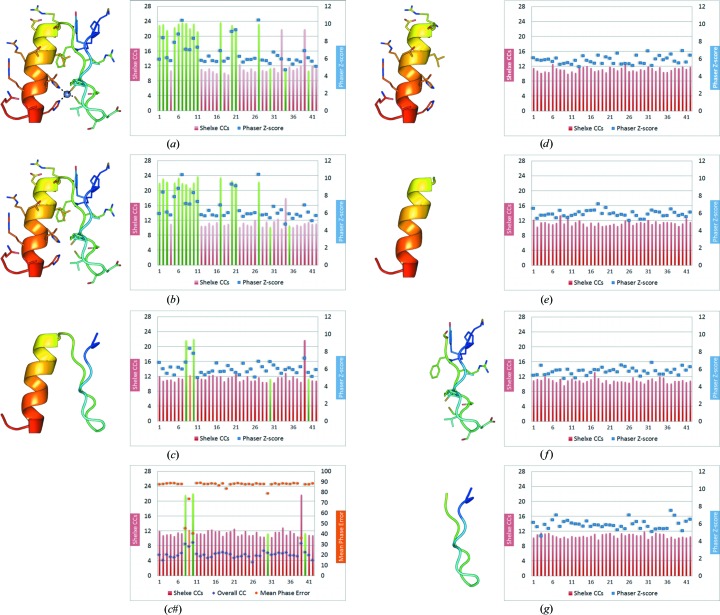Figure 3.
Zinc-finger fragments used as search models (PDB code 1f2i is shown as an example). The zinc-finger fragments were truncated stepwise during the target structure-solution procedure to investigate systematically the tradeoff between fragment completeness and accuracy of the binding motif for the solution of this class of proteins. The models used are shown in cartoon representation on the left and the Phaser and SHELXE results are shown in diagrams on the right, where the green and red bars represent the SHELXE CC and the blue squares represent the Phaser TFZ score (the PDB codes corresponding to the numbers on the x axis can be found in Table S1 of the Supporting Information): (a) zinc-finger fragment without truncation (27–31 amino acids; 30–35% of the original zinc-finger fragment), (b) fragment omitting the Zn atom, (c) side chain truncated to polyalanine residues spanning the whole zinc-finger motif, (d–g) fragment subsets containing only helix or β-strands with and without side chains: (d, e), 8–13 amino acids, 9–15% of the original zinc-finger fragment, (f, g) 13–16 amino acids, 15–18% of the original zinc-finger fragment. H atoms were always omitted from the different fragment subsets. Diagrams show ARCIMBOLDO runs started with a subset of zinc-finger fragments. Attempts in which ARCIMBOLDO succeeded in solving the PDB entry 2WBS target are shown as green SHELXE CC (correlation coefficient) values (fragment PDB codes are listed at the bottom). (c#) shows the OCC (overall correlation coefficient of the fragment before density modification) and final MPE (mean phase error) after density modification and auto-tracing with SHELXE. (e) shows fragment subsets truncated to polyalanine and only helix polyalanine cases. The use of helical or β-strand fragments themselves (for example, general fragments for ab initio structure solution with ARCIMBOLDO) does not lead to any feasible solutions. In contrast, retaining the motif but truncating the side chains (c) is successful in some cases. The smallest solving fragment represents 14.18% of the mass of the asymmetric unit.

